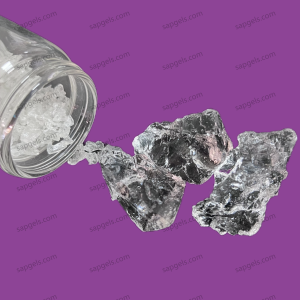Potassium polyacrylate is a superabsorbent polymer celebrated for its extraordinary water retention abilities. This versatile material plays a crucial role in fields like agriculture and horticulture, significantly improving soil moisture retention. Let’s explore the intricacies of potassium polyacrylate, including how it absorbs water, its mechanism, production process, and durability.

The Science Behind Water Absorption
Potassium polyacrylate’s impressive water absorption stems from its distinct molecular structure. As a polymer, it consists of long chains of repeating units derived from acrylic acid, integrated with potassium ions.
When potassium polyacrylate encounters water, water molecules are drawn to the potassium ions and the hydrophilic sections of the polymer. The potassium ions dissociate from the polymer, creating negatively charged sites along the polymer chain. These negatively charged sites attract polar water molecules, causing the polymer to swell and transform into a gel-like substance capable of holding large quantities of water.
How Potassium Polyacrylate Functions
The functionality of potassium polyacrylate involves several key stages:
- Water Contact: Upon encountering water, the dry potassium polyacrylate’s hydrophilic sections and potassium ions attract the water molecules.
- Absorption and Expansion: Water molecules penetrate the polymer structure, adhering to the negatively charged sites, which causes the polymer chains to expand and form a gel-like substance.
- Achieving Equilibrium: The polymer continues to absorb water until the osmotic pressure driving water into the polymer balances with the elastic forces of the swollen polymer network.
Production Process of Potassium Polyacrylate
Creating potassium polyacrylate involves a series of steps:
- Polymerization: The process begins with polymerizing acrylic acid, combining its monomers into long chains through free radical polymerization.
- Neutralization: The polymerized acrylic acid is neutralized with potassium hydroxide, converting it into potassium polyacrylate and introducing the essential potassium ions.
- Drying and Grinding: The resulting gel is dried to remove excess water and ground into a powder or granule, making it suitable for various applications.
Durability of Potassium Polyacrylate
The lifespan of potassium polyacrylate varies based on its use and environmental conditions. In dry, controlled environments, it can last indefinitely, maintaining its water-absorbing properties. However, once it absorbs water and forms a gel, its stability can differ:
- In Agriculture and Horticulture: When used in soil to improve moisture retention, potassium polyacrylate can last from several months to a few years, depending on factors like soil composition, temperature, and microbial activity.
- Environmental Breakdown: Over time, exposure to UV light, heat, and microbial activity can degrade potassium polyacrylate. This degradation can take several months to years based on environmental conditions.
Conclusion
Potassium polyacrylate is a remarkable material with unique water-absorbing properties, making it invaluable in agriculture and horticulture. Its ability to absorb and retain water is due to its polymer structure and the presence of potassium ions that attract water molecules. The production process involves polymerization and neutralization of acrylic acid, followed by drying and grinding. While potassium polyacrylate can last indefinitely in a dry state, its longevity in practical applications depends on environmental conditions and usage.
In applications ranging from soil moisture enhancement to other innovative uses, potassium polyacrylate exemplifies the significant potential of polymer science in addressing water management challenges.

